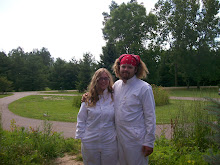


Today we removed our first super of honey!
About a month ago, Keith and I supered two of our Langstroth hives. We chose to put the empty super above the brood chamber, but below the other super of drawn honey comb.
Early in the spring the bee's we having trouble building on the comb without foundation, but Keith and I have chosen not to use foundation in our hives; in fact we are going to be phasing out our Langstroth hives and switch completely to top bar hives that are either Tanzanian or Kenyan top bar hives. In the meantime we chose to let the bee's continue on their way and draw out the comb. However with the progress that they have made, we decided to super them earlier than planned. With that progress that has led us to take the plunge, and harvest our first super of honey! Keith and I took the comb out carefully so we could harvest as much cut comb as possible. We took it home today (in our filled five gallon bucket!!) to crush the comb and extract the honey. We filled lots of lovely mason jars, various sizes and with both cut comb and strained honey, and are ready for the purchasing!
I must admit that it was simply thrilling to harvest our first honey super! It was so exciting to see all of that drawn and capped honey, and the variety of color! There was golden straw colored honey down to deep, almost molasses colored! The taste is magnificent! It's so floral, yet light, I don't want to brag, but I think our bee's have created the world's best honey! Plus, it's medication free. Many conventional commercial beekeepers choose to medicate as a preventative measure, but I, first of all, do not find it necessary to medicate something that is not sick, and secondly, to put an unnatural chemical onto a natural, agricultural, process that has been around for million's of year seems to me, pretentious. Hooray for honey! Save the honeybee!
I must also mention I have entered a new chapter in beekeeping by re-queening our first hive! Keith and I had noticed that we had a very creative, yet slightly unproductive, colony. We have a few pictures of the intricate comb they established, but that along with a heavy drone pattern (a lot of male bee's, which are not a integral part of the hive's survival) it is a sign that the hive should be re-queened to insure the entire colony isn't lost in the cold of winter. So far the progress has been promising, I think it has helped and we didn't even feel too guilty squashing the queen; but a little guilty, I must admit! Off to dream of sweet honey and saving our lovely honeybee!
About a month ago, Keith and I supered two of our Langstroth hives. We chose to put the empty super above the brood chamber, but below the other super of drawn honey comb.
Early in the spring the bee's we having trouble building on the comb without foundation, but Keith and I have chosen not to use foundation in our hives; in fact we are going to be phasing out our Langstroth hives and switch completely to top bar hives that are either Tanzanian or Kenyan top bar hives. In the meantime we chose to let the bee's continue on their way and draw out the comb. However with the progress that they have made, we decided to super them earlier than planned. With that progress that has led us to take the plunge, and harvest our first super of honey! Keith and I took the comb out carefully so we could harvest as much cut comb as possible. We took it home today (in our filled five gallon bucket!!) to crush the comb and extract the honey. We filled lots of lovely mason jars, various sizes and with both cut comb and strained honey, and are ready for the purchasing!
I must admit that it was simply thrilling to harvest our first honey super! It was so exciting to see all of that drawn and capped honey, and the variety of color! There was golden straw colored honey down to deep, almost molasses colored! The taste is magnificent! It's so floral, yet light, I don't want to brag, but I think our bee's have created the world's best honey! Plus, it's medication free. Many conventional commercial beekeepers choose to medicate as a preventative measure, but I, first of all, do not find it necessary to medicate something that is not sick, and secondly, to put an unnatural chemical onto a natural, agricultural, process that has been around for million's of year seems to me, pretentious. Hooray for honey! Save the honeybee!
I must also mention I have entered a new chapter in beekeeping by re-queening our first hive! Keith and I had noticed that we had a very creative, yet slightly unproductive, colony. We have a few pictures of the intricate comb they established, but that along with a heavy drone pattern (a lot of male bee's, which are not a integral part of the hive's survival) it is a sign that the hive should be re-queened to insure the entire colony isn't lost in the cold of winter. So far the progress has been promising, I think it has helped and we didn't even feel too guilty squashing the queen; but a little guilty, I must admit! Off to dream of sweet honey and saving our lovely honeybee!







